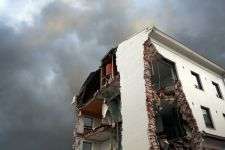Bond-style tech for emergencies

(PhysOrg.com) -- Instantly deployable James Bond-style information and communication technologies are now available to coordinate disaster response among diverse agencies and NGOs, thanks to European researchers.
Emergency crews approach a badly damaged building. The earthquake that struck four hours before left the town destroyed, but many people remain to be found. Eight different agencies are now on site, desperately trying to coordinate efforts to rescue survivors in the twisted landscape.
The team leader consults his PDA, linked via peer-to-peer (P2P) technology to dozens of databases with relevant information. According to the latest census, ten people normally live in the building. The operator is provided with the names and ages.
According to telephone records, two other people were in the building ten minutes before the earthquake struck. When the operator arrives at the rescue location, a city engineer is already running up, sent by the P2P-powered central dispatch.
Ten minutes and nine rescues
The engineer declares the building safe to search, and the team enters. As victims are found central dispatch is updated on their condition, and doctors are standing by. The team leader and central dispatch keeps track of the searchers through geo-tagging, which provides a live update of the team-members’ location in the building.
In ten minutes, nine people are rescued, one body is discovered, and the searchers learn from a conscious survivor that two people were away during the quake. The names of the absent are noted and sent to central dispatch, who can alert them on the status of their home and its occupants.
This is fiction, but it illustrates the coming paradigm for emergency response. Thanks to the work of European researchers at the Workpad project, special-ops style information and communication technologies will be available for instant deployment, easily tied to the databases of diverse emergency agencies and civil authorities, ready to make disaster rescue more safe and effective.
Tough problem
It was a tough problem, or rather many tough problems. Emergency response agencies, civil authorities and the NGOs who typically participate in disaster rescue and relief usually use different back-office systems, so they must be linked together. Then a network must be in place to link the back-office to the front line, where operators mostly use PDAs.
In all, the Workpad project worked on five allied major problems and dozens of minor ones. First, they developed a reference architecture, an overall scheme illustrating the most effective way of providing these diverse needs. That reference was a huge success for the project, receiving plaudits from the IEEE, a technology association, and now influencing ‘emergency internet’ standards at the W3C.
Next, Workpad developed a peer-to-peer data integration system on the back end. It is responsible, for example, for pulling together phone records, electoral registries, maps and geo-referencing, among dozens of other potential sources of useful information.
Large-scale collaboration
The project then moved onto large-scale collaboration and workflow in a mobile environment, a crucial piece of software that can define tasks, assign roles, and provide step-by-step instructions to the frontline. And it can be updated in real time, so if a more urgent need arises, workers can be interrupted to tackle another task.
The consortium also focused on the use of geo-referenced information to show a team-leader, for example, the location of all his or her team members.
“We started this project with a set of research ideas, technologies we thought would be useful,” explains Massimo Mecella, assistant professor at SAPIENZA University of Rome and technical manager of the Workpad project. “But we very quickly sought to get new ideas from the frontline operators. We wanted to deal with real problems, rather than solving problems we thought were important.”
Geo-referencing rescue operators was one of the refinements that came from user needs, allowing leaders to know where people are at any time.
Finally, the project looked at a variety of communication technologies to ensure the system could be set up and transmit in a matter of hours, and that it can adapt to the most appropriate available technology at any site.
90 journal papers
The system underwent a test in southern Italy, and performed with flying colours, receiving the enthusiastic endorsement of veteran emergency teams. Workpad’s peers, in academia and elsewhere, have been enthusiastic, and the team produced over 90 journal and conference papers on their work.
But there is more work to be done, and the Workpad team has been encouraged to seek further funding under the European Union’s Seventh Framework Programme for research.
“There is a lot of work we did, and we could do a lot more. For example, the system records all the actions undertaken by various teams, and how the entire operation progresses,” notes Mecella.
“While the system already records, we could develop software to analyse how an intervention progressed, and perhaps do some data mining to find better, more effective ways to respond to an emergency in the future.”
There are other similarly interesting questions the partners could explore, such as using sensors with frontline workers, PDAs with team leaders and even using independent environmental sensors dropped across the disaster zone.
Ready to use
But the technology developed by Workpad is ready for use in the real world now, and may do so soon. Currently, a proposal for deployment in the Calabria region of Italy is under consideration. Calabria is a good candidate, because it suffers every year from both flooding and fires, which require frequent emergency response. “The plan would see 1500 PDAs deployed among emergency workers,” notes Mecella. Authorities in the Czech Republic, too, are considering deployment.
In all, it is an impressive list of achievements for a relatively small project, with a budget of just €3.16 million, €1.85 million provided by the EU. And it will mean technology helping frontline disaster workers to save lives.
More information: Workpad project - www.workpad-project.eu/
Provided by ICT Results

















